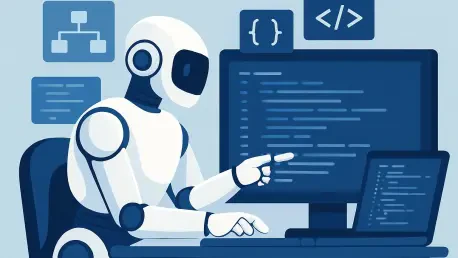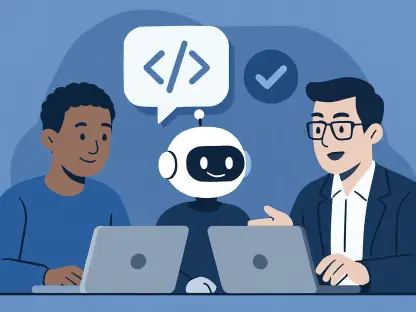In an era where software development is increasingly driven by automation, the introduction of advanced AI models has become a game-changer for programmers and tech companies alike, transforming how code is created. Imagine a tool that can generate complex code snippets in a fraction of the time it would take a human developer, while also adapting to intricate contextual requirements with ease. Salesforce AI Research has unveiled a remarkable innovation with CoDA-1.7B, a 1.7 billion-parameter diffusion-based language model tailored specifically for code generation. This cutting-edge model challenges conventional approaches by leveraging discrete diffusion techniques, offering a fresh perspective on how AI can streamline coding tasks. Unlike traditional methods that build code sequentially, this model processes multiple tokens simultaneously, promising efficiency and adaptability. As the tech landscape continues to evolve, understanding the impact of such advancements becomes essential for staying ahead in the competitive field of software development.
Breaking New Ground with Diffusion-Based Code Synthesis
The foundation of CoDA-1.7B lies in its unique diffusion-based architecture, a departure from the autoregressive models that have long dominated AI code generation. Traditional models predict code tokens in a strict left-to-right sequence, often missing the broader context of a program. In contrast, CoDA-1.7B employs a bidirectional denoising process, enabling it to update multiple tokens across entire sequences in parallel. This method, paired with full-sequence attention, allows for native infilling and non-autoregressive decoding, making the model adept at handling complex code structures. By iteratively refining masked sequences, it captures the full context of a coding task, rather than being constrained by a linear generation order. Such an approach not only enhances the accuracy of the generated code but also opens up new possibilities for tackling sophisticated programming challenges with greater precision and insight into the overall structure of the intended software solution.
Another key aspect of this groundbreaking model is its ability to significantly reduce inference latency, a critical factor for real-world applications. The parallel token generation enabled by the diffusion framework means that developers can receive outputs much faster than with traditional sequential models. This efficiency is further supported by features like confidence-guided sampling and entropy-style decoding, which allow users to fine-tune the balance between speed and quality. Salesforce AI Research has also provided both Base and Instruct checkpoints, catering to diverse use cases ranging from general code synthesis to instruction-based tasks. Accompanied by a comprehensive pipeline for training, evaluation, and deployment, CoDA-1.7B stands as a practical tool that can seamlessly integrate into existing workflows. This focus on usability and performance underscores the model’s potential to transform how developers approach coding, making it a vital asset in fast-paced tech environments.
Performance Metrics That Challenge the Status Quo
When evaluating the effectiveness of CoDA-1.7B, benchmark results paint a compelling picture of its capabilities compared to other models in the field. The Instruct variant of this model achieves impressive pass@1 scores, including 54.3% on HumanEval, 47.6% on HumanEval+, 47.2% on MBPP, and 63.2% on MBPP+, with an aggregate score of 55.4% on EvalPlus. These numbers position CoDA-1.7B as a strong competitor, even against larger diffusion models like Dream-7B-Instruct, which scores 57.9% on HumanEval, despite having a much larger parameter count. This efficiency in performance-per-parameter reflects a growing trend in AI research toward creating compact models that deliver high-quality results without the heavy computational demands of bigger architectures. For organizations with limited resources, this balance of power and efficiency makes the model an attractive option for enhancing coding productivity without breaking the bank on infrastructure.
Beyond raw scores, the operational flexibility of CoDA-1.7B adds to its appeal for practical deployment. The model’s inference behavior is highly customizable, with generation costs tied to the number of diffusion steps and adjustable parameters such as algorithm type, temperature, and block length. These settings empower users to optimize latency and output quality based on specific project needs, a feature particularly valuable for developers aiming to maximize throughput in real-time applications. Compared to larger diffusion models, CoDA-1.7B targets lower wall-clock latency at similar step budgets, proving its suitability for smaller-scale deployments where speed is critical. This adaptability ensures that the model can meet the diverse demands of software development, from rapid prototyping to detailed code refinement, positioning it as a versatile tool in the ever-evolving toolkit of modern programmers.
Accessibility and Deployment for Real-World Impact
Ease of integration is a cornerstone of CoDA-1.7B’s design, reflecting a commitment to making advanced AI accessible to a broad audience. Salesforce AI Research has equipped the release with a FastAPI server featuring OpenAI-compatible APIs and an interactive command-line interface for local inference, simplifying the process of embedding the model into existing systems. The repository offers detailed setup instructions and a launcher script to streamline deployment, ensuring that even those with limited technical expertise can get started quickly. Model weights and artifacts are hosted on Hugging Face under a CC BY-NC 4.0 license, promoting wide access for non-commercial purposes. This focus on user-friendly deployment tools highlights the model’s potential to democratize cutting-edge code generation technology, allowing developers and researchers alike to leverage its capabilities without facing steep barriers to entry.
Further enhancing its real-world applicability, the training methodology behind CoDA-1.7B follows a structured three-stage pipeline that includes pre-training with bidirectional masking, supervised fine-tuning, and progressive denoising during inference. This approach ensures that the generated code is both coherent and contextually relevant, addressing common pitfalls in AI-driven code synthesis. The open-source nature of the training pipeline, complete with reproducible scripts for TPU pre-training and GPU fine-tuning, fosters transparency and encourages community collaboration. By providing these resources, the research team enables others to build upon the model’s foundation, potentially driving further innovation in discrete diffusion techniques. Such openness not only strengthens the model’s credibility but also positions it as a catalyst for collective progress within the AI and software development communities.
Paving the Way for Future Innovations
Reflecting on the release, it becomes clear that CoDA-1.7B sets a new standard for AI-driven code generation through its innovative use of discrete diffusion and bidirectional context handling. Its competitive performance on benchmarks like HumanEval and MBPP, coupled with a focus on low-latency inference via parallel token updates, marks a significant leap forward. The customizable inference parameters offer a nuanced balance between quality and speed, while comprehensive deployment resources ensure ease of adoption across various settings. Looking ahead, the next steps involve exploring how this model can be further optimized for specialized coding domains or integrated with other AI tools to create even more robust development environments. Continued community engagement through open-source contributions will be crucial in refining its capabilities. Additionally, investigating ways to scale its efficiency for commercial applications could unlock new opportunities, ensuring that advancements like CoDA-1.7B continue to shape the future of programming with practical, impactful solutions.









